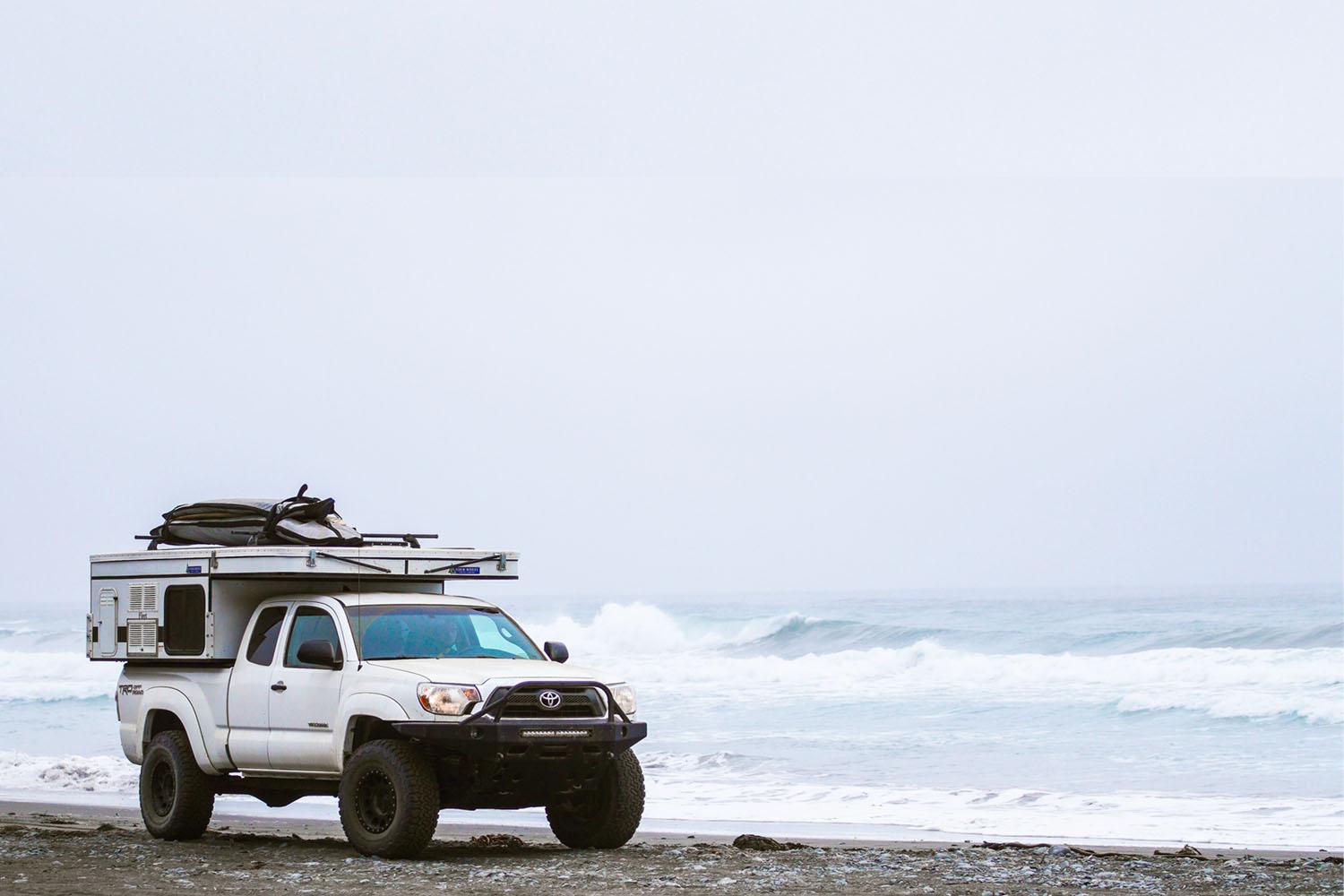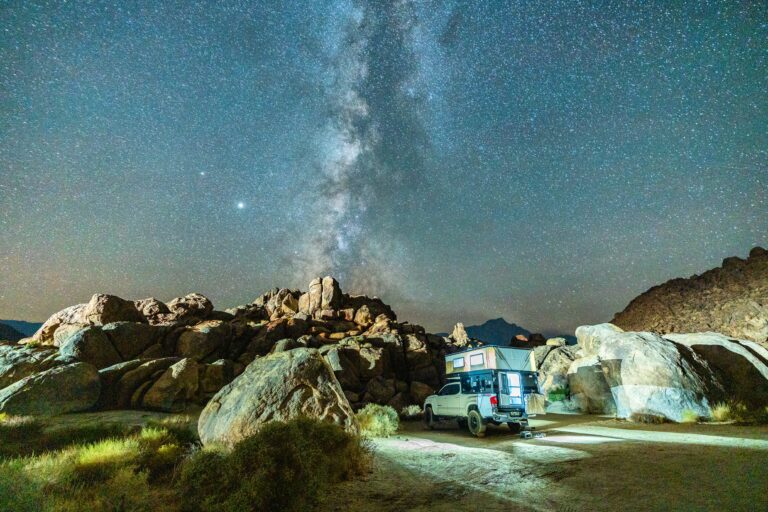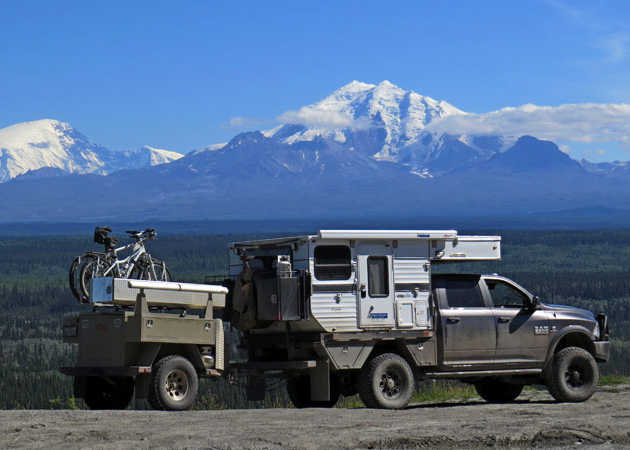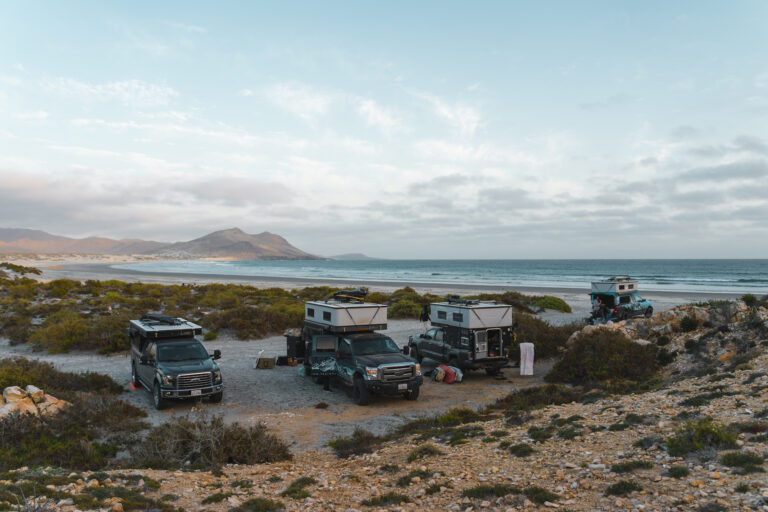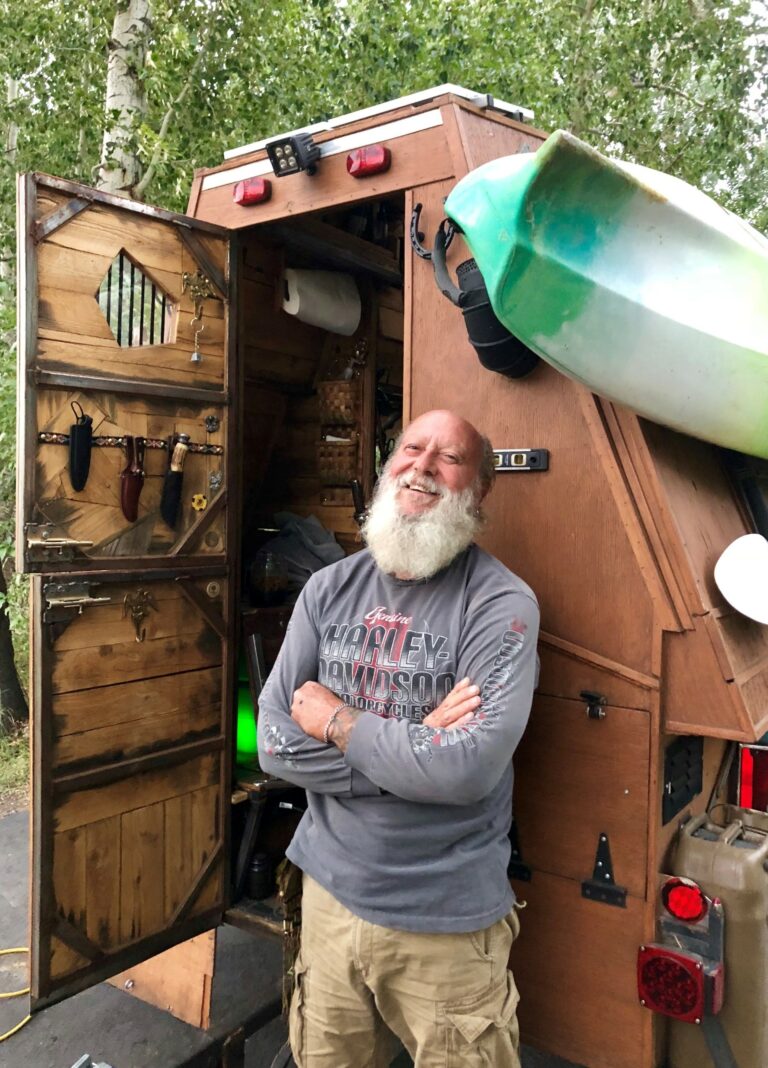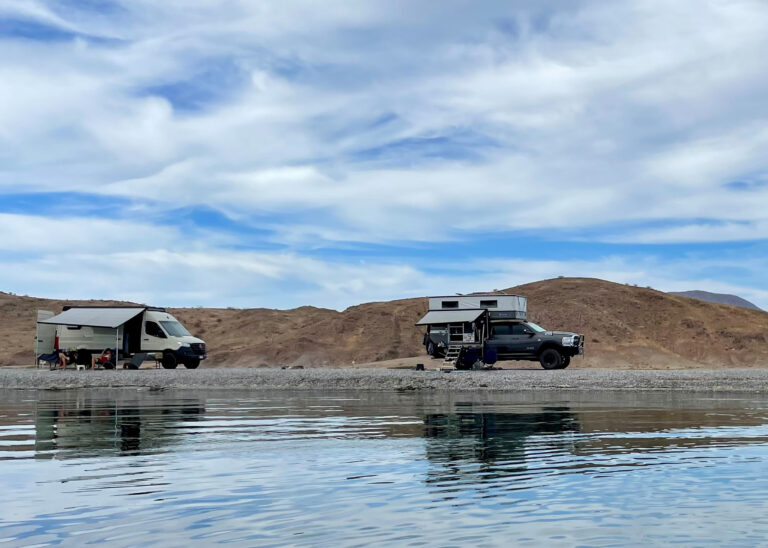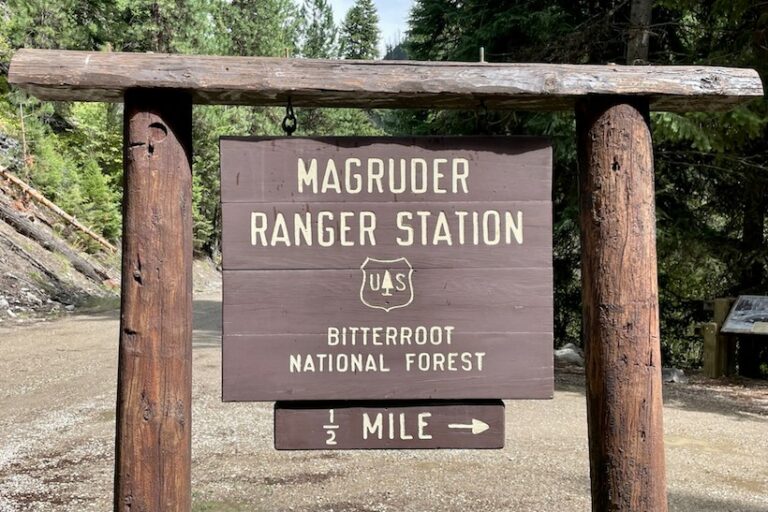
Top 20 Tips For Travelling Down The West Coast Of America In A Campervan
The pull of the open road down the West Coast of America is something that has attracted tourists and thrill seekers from all over the globe for decades. Sun, surf, sea, forests, beaches, and incredible scenery await all those who arrive in California, and with a campervan or tiny trailer in tow, it’s never been easier to call beautiful vistas home for the night, making memories that will last a lifetime along the way.
I’ve spent the past 3 weeks travelling down the West Coast of America in a Grandby Flatbed Truck Camper from Four Wheel Campers, living both off-grid and in campsites in a bid to come up with the ultimate guide to living comfortably on the road, seeing California for less and enjoying both bustling cities and the tranquillity of nature.
It doesn’t matter whether you’ve lived in a van for many years like me or are new to the concept of travelling in a truck camper, these 20 tips will set you on the right path and get you on your way to living like a nomad, taking the stress out of your trip and leaving you free to enjoy the ride!
So, what are you waiting for; let’s get discovering how to travel down the West Coast of America and kickstart the journey of a lifetime!
1. Plan Your Route And Major Campsites In Advance

California has some of the most stunning places on the planet to visit; Yosemite, the Giant Redwoods inside Sequoia National Park, Death Valley, and Joshua Tree National Park to name a few.
For those not in the know, camping is only permitted in designated campgrounds within National Parks, which means that if you’re planning on visiting these areas on your trip, then you’re going to need to book your campsite well in advance.
Many of the campsites for the major attractions get booked up 6 months in advance, so make sure to get these sites booked in first as what I like to call ‘cornerstone destinations’ that will define the general route of your trip.
Some sites have a lottery system where you can rock up at 5.30 am and take a slot on a first-come-first-served basis, so that is always an option for those that are trying to keep the planning to a minimum, but just remember that you’re not guaranteed or entitled to a slot through this method.
2. Be Flexible With Your Route
This is something that I’ve learned from many years of full-time vanlife – keep your route flexible and try not to be too stringent with your plan. I know that’s hard if you’re only travelling down the west coast for a week, but there’s so much to see that if you do have the time to spend longer in a place, then take as much time as you can and see everything there is to see.
The plan for my 2023 California road trip had to be changed due to 150 years of snow falling in Lake Tahoe and Yosemite. I can get snow and cold weather back in the UK, so I’ve spent 3 weeks heading to surf spots in warmer climates instead, hanging out with the friendly people of SoCal and soaking up the sun.
You can’t plan for every eventuality, and your arrival and departure dates from the USA will obviously stay fixed, but try to go with the flow when it comes to picking places to go. California is so relaxed that, once you’re here, you’ll have no problem chilling down and going wherever the road takes you.
3. Make Friends With The California State Parks Website
I arrived in California with no campsites booked and just a hotel to stay in the night of my arrival before picking up my Four Wheel Campers rig. I wanted to ‘wing it’ and see how easy it is to find places to stay on the fly, and one of the best resources I can recommend for those wanting security, electrical hook-up, water, and some incredible views to finish off the entire package is the California State Parks website.
With a simple booking system and options for nearby campsites if your chosen site is booked up, it’s super easy to find a pitch for the night, with most campgrounds costing as little as $35 to stay for the night.
Top put that in context, that’s around £28 or €32, and your camping ticket gets you free parking in any other California state park for both the day of your arrival and until sunset on your day of departure, which makes it a great tool if you want to visit multiple places in one day!
4. Check County Websites For Road Closures

My plan was to head all the way down Highway 1, stopping off in places along Big Sur and spending a lot of time on this iconic road. Unfortunately, I found that large portions of the road were unusable due to storm damage, bad weather that I luckily missed by a couple of weeks.
Hopefully, as you’re reading this, that will all have been sorted out, but the best way to check for any potential road closures is on individual county websites. They’ll tell you about local road closures as well as giving you updates on the weather and fire risks in certain areas.
I would recommend checking these websites while you do a little bit of initial route planning before arriving in the US and keeping an eye on each website once you land and start your road trip. The elements tend to have a mind of their own and can change very quickly, so it;’s best to keep an eye on updates every day.
5. Look To iOverlander For Water spots
Water is such an important amenity while travelling on the road, and if you’re cooking on the go or your camper or motorhome has an inbuilt shower, then it can go down very quickly.
iOverlander is a great resource for those looking to find free places to camp, but it’s also invaluable for finding places to fill up with freshwater on the go. If you’re staying on campsites, then you won’t really have a problem here, but if you’re wild camping or ‘boondocking’, i.e. camping for free in forests or on the side of the road, then these water fill up spots will definitely come in handy.
iOverlander, like Park4Night and other user-led apps, allows campers to upload places of interest, toilet disposal sites, water spots, scenic areas, and other useful tips for vanlifers. Definitely check it out and keep the app handy; it’ll certainly help you out while travelling down the West Coast!
6. National Forest & BLM Land are Free To Camp On
Speaking of boondocking, if you’re looking to ditch the campsites completely and camp freely out in the world away from people, then you need to be looking out for National Forest sites and BLM (Bureau of Land Management).
BLM land accounts for around 245 million surface acres of land in the United States, and it’s all free to camp on so long as you stay for 14 days of less in any one area. National forests work in a similar manner and are free to camp on, but some areas do require you to have a permit before entering.
One word of advice – just make sure to be ‘bear aware’ in these areas as you’re often going to be sharing these spaces with animals of all shapes and sizes.
For more information on how to camp safely in these areas, check out the National Forest BLM websites
7. Pack All The Essentials For Life On The Road

Let’s talk about what essentials you might need while out on the road.
While travelling down the West Coast in a Four Wheel Camper, one of the most useful items I’ve turned to time and time again has been a head torch. They’re invaluable at night when heading to the toilet, or just for looking in the back of cupboards or finding things in the under-bed storage in the Grandby set-up that you’re seeing through these pictures.
Other items I’ve turned to have been a portable Bluetooth speaker, my laptop for writing on the go, my phone for mobile internet (I’m coming to that important point in a second) and kitchen equipment for cooking.
Apart from that, the Grandby has had everything else that I’ve needed – a place to work, a place to sleep, a burner and fridge for all of my cooking needs, a sink for washing up, and more electricity that I’ve known what to do with thanks to the included solar panels on the Grandby’s pop-up roof!
8. Don’t Overpack & Look To Thrift Stores For Anything You Need
Don’t go wild with your packing, however. I brought a large suitcase with me with enough clothes to last me my 21-day trip along the coast, forgetting that I was coming to a country where I both spoke the language and where everything was readily available for me to buy incredibly easily should I need it.
In the first couple of days, I visited a Walmart to buy cooking utensils and supplies, and I turned to Good Will for everything else that I needed including a couple of jumpers ad some cups that I’m taking back home with me.
It turns out that the big suitcase was useful because of all the stuff that I’ve since bought, but if you’re planning on travelling light, buying from one thrift store and giving back to another at the end of a trip is a perfect way of acquiring what you need and helping out a charity at the same time!
9. Not All Gas Stations Sell Diesel
If you’re taking out a Truck Camper on the back of a Dodge Ram 3500 like I did, then you’re going to need to top it up with diesel once in a while. One thing that I’ve discovered from this latest trip is that not all gas stations sell diesel like they do back in the UK and Europe, even when Google or Apple Maps tells you that they do.
Some Chevron and Shell branches sell Diesel, while others don’t. If in doubt, ask the cashier where the nearest diesel station is, and they’ll point you in the right direction. Look out for green numbers on the pricing boards while driving past – gas is red, and diesel is green, and the price is always cheaper if you’re paying in cash!
10. Buy An American Sim Card For Your Stay

Whether you’re planning on staying in the US for 9 or 90 days, it’s much easier and far less expensive to buy a temporary sim card while you’re out here.
I need mobile internet to write and upload articles on the go, so it’s important that I have unlimited data and unlimited calls and texts for contacting friends and colleague while in the States. T-Mobile do a great monthly SIM package that you can prepay for when you arrive, giving you unlimited everything and great 5G internet along the way. This cost me around $60 and has allowed me to FaceTime family back home, use Maps, book campsites, post on social media, listen to Spotify, and upload articles without incurring a huge bill from my mobile provider back in the UK… who were planning on charging me £15 per 2Gb of data!
11. Shop Around For The Cheapest Supermarket
Like water, food is one thing that is an essential for life on the road. And I don’t want to shock you, but food is not cheap in America. I recently spent $10 on some dried basil, which is a lot more expensive than the £0.69 it costs back in Aldi in the UK. I’ve spoken with a few vanlifers here in California who have also told me that food shopping can get very expensive, which is why it’s important to shop around for the best deals.
Most supermarkets do have deals that make things a little easier on your wallet or purse, and if you shop around and don’t mind driving to different places to do your full shop, then it does become a lot more cost effective. Target and Safeway both have discount programmes, with Safeway giving great discount on alcoholic beverages and some cupboard items so long as you have a US sim card (which you should after reading the point above!)
The best supermarket I’ve found for buying produce is Food4Less. I mean, the name caught me straight away after I’d spent $11 on halloumi in the previous supermarket, and now they have my custom for life!
12. Weigh Up cooking In Your Van VS Eating Out In Touristy Hotspots
If you’re only here for a few days or are planning on visiting touristic hotspots and not spending a lot of time cooking in your van, then eating out at fast-food restaurants along the coast can be a lot more cost effective, especially when you can get a Double-Double and fries at In-N-Out burger for less than a jar of dried basil!
Places like Taco Bell, Chipotle, Starbucks, Panda Express, In-N-Out Burger, Subway, and of course McDonalds have a great selection for travellers on a budget. I’m not saying it’s something that you should be doing everyday (though I have had far too many Double-Doubles so far), but you certainly won’t go hungry if you stick to these places.
13. Look To Truck Stops For Showers
The Grandby I’m taking around with me has an outside shower system, but many Four Wheel Campers and RVs also have showers inside for campers to use on the go.
If, however, you don’t want to be continuously filling up with water, then Truck Stops are a great place to get showers while travelling down the West Coast.
For just 50¢, you can get a warm shower and keep clean while travelling. It’s a cheap solution if you’re travelling on a budget and you might even pick up some great places to visit from truckers too!
14. Plan Restroom Breaks On Your Routes

One thing that I’ve found from the years I’ve spend travelling with Four Wheel Campers is that everything in America is far away. A long drive in the UK is 3 hours, whereas everything seems to be around 4 hours minimum here in California. I love driving, and if anything, it’s a great way of seeing everything there is to see in America at your own pace.
But with long drives comes the unavoidable need for bathroom breaks.
If you’re in the wilderness and have a spade to hand, then you’re pretty much set. But, if you’re scheduling in restroom breaks at supermarkets or restaurants, then make a note of their closing times before you set off on your route so you’re not ‘caught short’.
Not all supermarkets are 24 hours anymore, and some restaurants only provide drive-through services after 9pm, so it’s best to do your due diligence with this one, especially if you’re travelling with children!
15. Don’t Be Afraid to Camp In Parking Lots

Churches also allow overnight parking too if you’re out of options and looking for a spot for the night; just make sure to speak to the priest either before or after your stay, and it’s always nice to make a donation as a gesture of good will before you go.
16. Check Out Local Fire Regulations
California has strict rules on wood gathering and fires that need to be followed in order to prevent wildfires, especially in times of drought. You’ll also find that many campsites have a ‘no log burning’ policy, and you can incur a fine if you don’t follow the rules.
If campfires are high up on your West Coast road trip bucket list, then stock up on Wax Dermaflame logs before you head out on the road. They burn well, provide a good amount of heat, look great on your pictures, and are much safer for the environment!
17. Have A Good Knowledge Of Your Vehicle Before You Travel Into Remote Places

Before you drive away in any vehicle, make sure you make a note of how high, long, and wide it is. A good tip is to write the measurements on a post-stick note and place it on your steering wheel or dashboard so you have them to hand before heading through a tunnel or underneath a height barrier.
Take some time to practice reverse parking in an empty parking lot too – everything is bigger in America so you shouldn’t have many problems driving (don’t forget that they drive on the right here too!), but it’s always good to practice handling a vehicle that you’re not used to before taking it out around other cars in supermarket parking lots or busy towns.
It’s also a great idea to get some basic knowledge as to how the batteries work, where fresh water goes in, what size gas bottles you have, where the fuses are, and how the toilet empties etc before you drive away into the desert where you have no phone signal.
And if all else fails, make sure you take a copy of Van Life for Dummies on the road with you too and I can help you out from afar.
18. Make Sure You Have Knowledge Of Your Breakdown Company Or Take Out Cover Before You Arrive
I know you don’t want to think about breakdown cover when all you’re wanting to do is get cracking with your road trip down the West Coast, but accidents can and do happen, so it’s important to know who you need to call should something happen to you or your vehicle or if you get into trouble on the road.
Make a note of the number of your rental company or take out cover with a breakdown company before setting off, taking care to note what you’re covered for if you do breakdown.
And for any emergencies, make sure to call 911 immediately.
19. Get Off The Beaten Track

If you’re renting or buying a Four Wheel Camper for your trip, then it certainly pays to get off the beaten track once in a while. The same can be said for getting out of your van and exploring on foot too; so many people only see what is right in front of them and don’t look further afield, and as long as you have a map to follow and are proficient with a compass, then there’s no reason why you shouldn’t get out there and explore some of the incredible trails that the West Coast has to offer.
AllTrails is a great sight for finding walking trails while travelling, so grab a good pair of walking boots and head out in search of some hidden wonders!
20. Speak to Locals For Great Spots
The people of California are some of the friendliest people that I’ve met on my travels around the world. They’re immensely proud of their state and are more than willing to give advice when it comes to places to visit, be it great spots to dine out or amazing must-see sights that you have to visit on your trip.
Gathering local knowledge is another reason keeping your trip flexible is so important; you might have a certain route in mind, only to speak to a campsite warden who tells you about a little-known village in a different direction that has taken inspiration from the Netherland sand has some incredible food to try before you fly home.
Please use local knowledge wisely, leave spaces tidy, and don’t plaster the places they tell you all over the internet. After all, part of the journey is discovering places for yourselves. And who knows, you might even find your own secret spot that you can tell someone about yourself one day!
So, there you have it; 20 tips for travelling down the West Coast in a campervan! I hope you’ve picked up some useful tips and have a much better idea of how to tackle a road trip down one of the most interesting and vibrant coastal routes in the world.
Don’t forget to check out Four Wheel Campers for more invaluable guides such as the Best Places To See Wildflowers In California and more of the Best Websites To Find Campsites on your travels!
Related News
-
Best Surf Spots in America
We’ve seen more and more surfers come up and join the Four Wheel Camper family. I mean, our slide-in campers DO make a ...
Read More -
Reasons You’ll Regret an RV in Retirement
Congratulations, retiree! Stepping into retirement is a big deal – the world is at your fingertips! You want to ...
Read More -
Four Wheel Campers Hosts Third Annual Volunteer Event in Southern Arizona
In March 2024, Four Wheel Campers returned to the Sonoran Desert for our third annual volunteer event with Friends of Buenos ...
Read More -
Best Places to Stargaze in the United States
The moment your pop up truck camper is set up, the fire is lit, and the stars arrive, is one of the best feelings, especially ...
Read More -
The Perfect Campsite Challenge
Read the Full Article
Read More -
Lightweight Pop-Up Truck Campers: Hub-and-Spoke RVing with Boundless Adventures
Read the Full Article
Read More -
8 Breweries You Can Camp At With Your Four Wheel Camper
There’s nothing like a cold brew after a long day of travel. Better yet, there is nothing better than a cold hard brew at a ...
Read More -
Veteran and his Artistic, Off-Grid Lifestyle
We know our customers are special. Four Wheel Camper customers not only appreciate quality, efficiency, and great ...
Read More -
FWC Customer Pens Emotional Tribute
We know our customers are special. Four Wheel Camper customers not only appreciate quality, efficiency, and great ...
Read More -
7 Tips for Living on The Road Full Time From Industry Experts
Sometimes it’s the little details that get overlooked when prepping to live on the road full-time in your truck camper rig or ...
Read More -
Ski Resorts Where You Can Winter Camp in the Parking Lot
Embarking on a winter camping adventure offers unparalleled satisfaction, especially when you wake up snug and on-site in ...
Read More -
A Magruder Corridor Trail Adventure
Read the Full Article
Read More

